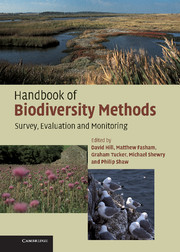Book contents
- Frontmatter
- Contents
- Preface
- Acknowledgements
- Part I Planning
- Part II Habitats
- Part III Species
- 9 Introduction to species assessment
- 10 General principles and methods for species
- 11 Fungi
- 12 Lichens
- 13 Bryophytes
- 14 Aquatic macrophytes and algae
- 15 Vascular plants
- 16 Dragonflies and damselflies
- 17 Butterflies
- 18 Moths
- 19 Other terrestrial invertebrates
- 20 Aquatic invertebrates
- 21 Fish
- 22 Amphibians
- 23 Reptiles
- 24 Birds
- 25 Bats
- 26 Other mammals
- Appendix 1 Monitoring and reporting obligations under international conservation agreements
- Appendix 2 Relationship between BAP Priority Habitat and Broad Habitat categories and Habitats Directive nomenclature
- Appendix 3 Annotated list of key references for plant identification
- Appendix 4 Determining appropriate quadrat size for vegetation sampling
- Appendix 5 The relocation of permanent plots
- Appendix 6 Equipment required for undertaking different types of survey
- Recommended sources of further information
- References
- Glossary
- Index
18 - Moths
Published online by Cambridge University Press: 01 September 2010
- Frontmatter
- Contents
- Preface
- Acknowledgements
- Part I Planning
- Part II Habitats
- Part III Species
- 9 Introduction to species assessment
- 10 General principles and methods for species
- 11 Fungi
- 12 Lichens
- 13 Bryophytes
- 14 Aquatic macrophytes and algae
- 15 Vascular plants
- 16 Dragonflies and damselflies
- 17 Butterflies
- 18 Moths
- 19 Other terrestrial invertebrates
- 20 Aquatic invertebrates
- 21 Fish
- 22 Amphibians
- 23 Reptiles
- 24 Birds
- 25 Bats
- 26 Other mammals
- Appendix 1 Monitoring and reporting obligations under international conservation agreements
- Appendix 2 Relationship between BAP Priority Habitat and Broad Habitat categories and Habitats Directive nomenclature
- Appendix 3 Annotated list of key references for plant identification
- Appendix 4 Determining appropriate quadrat size for vegetation sampling
- Appendix 5 The relocation of permanent plots
- Appendix 6 Equipment required for undertaking different types of survey
- Recommended sources of further information
- References
- Glossary
- Index
Summary
This chapter refers largely to the macromoths, although many of the techniques are also applicable to micromoths. Most macromoths are nocturnal, and this poses some problems for survey and monitoring. For many species, light traps are the only reliable way of confirming the presence of adults.
Adult moths are mostly highly mobile and rarely site-specific, but larvae often live in discrete areas of suitable habitat. Such habitats may be large in the case of grass-feeding species or very small and discrete in the case of leaf miners. Separate populations may also exist within areas of suitable habitat.
Monitoring areas of suitable habitat may be appropriate, particularly if resources are not available for more detailed survey methods. Monitoring of micro-habitats is not specifically covered in this Handbook. However, some of the techniques in Part II may be adapted for this purpose.
ATTRIBUTES FOR ASSESSING CONDITION
Population range
Area of occupancy is an important attribute to monitor and can be best assessed by mapping presence–absence. Repeat surveys will illustrate expansions or contractions of range.
Colony number
As mentioned above, adult moths are highly mobile whereas larvae often live in discrete areas. The number of colonies may therefore apply more to larval populations than to adults.
The number of populations occurring in a site is a straightforward indication of the overall health of the species in the defined area.
- Type
- Chapter
- Information
- Handbook of Biodiversity MethodsSurvey, Evaluation and Monitoring, pp. 335 - 340Publisher: Cambridge University PressPrint publication year: 2005



